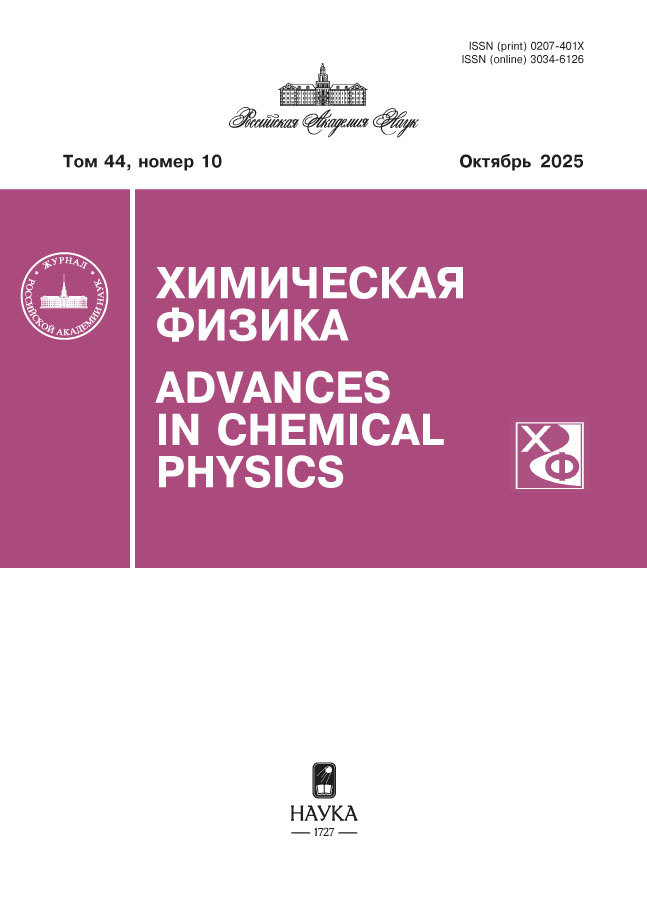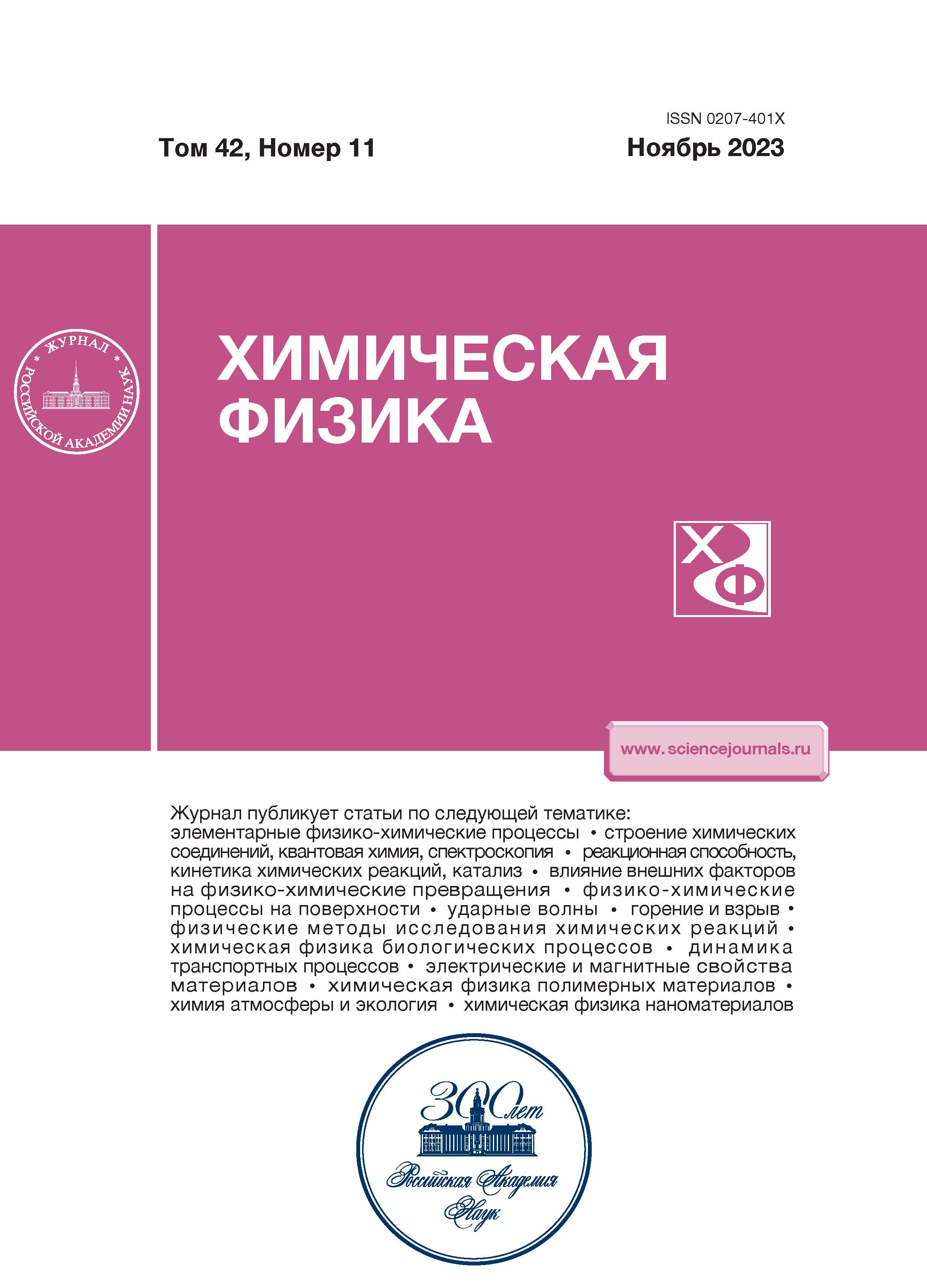Том 42, № 11 (2023)
Химическая физика полимерных материалов
Диэлектрические свойства композитов на основе этиленвинилацетата, наполненного голландитоподобным керамическим материалом K1.5Co0.75Ti7.25O16
Аннотация
В качестве перспективных материалов для компонентов электронных устройств в работе получены и исследованы полимер-матричные композиты на основе этиленвинилацетата и твердого раствора состава KxCoyTi8–yO16 с голландитоподобной структурой (KCoTO(H)). Синтез наполнителя осуществлен путем модифицирования рентгеноаморфого соединения полититаната калия K2O · nTiO2 (n = 4.3) в растворе CoSO4 · 7H2O в щелочных условиях с последующей температурной обработкой при 900 °С. Структура синтезированного материала и морфология частиц исследованы методами рентгеновского фазового анализа и сканирующей электронной микроскопии соответственно. Введение KCoTO(H) в полимерную матрицу этиленвинилацетата проведено посредством смешения предварительно приготовленных раствора полимера и дисперсии порошка-наполнителя в соответствующем растворителе в количествах 10, 20, 30, 40 и 50 об.%. Методом импедансной спектроскопии исследовано частотное поведение диэлектрической проницаемости, тангенса угла диэлектрических потерь и проводимости полученных композитов. Установлено, что увеличение содержания KCoTO(H) в составе композита способствует росту исследованных диэлектрических характеристик относительно чистой полимерной матрицы этиленвинилацетата во всем частотном диапазоне 0.1 кГц–1 МГц.
 3-8
3-8


Влияние внутренней микроархитектуры на форму индивидуальных имплантатов, изготовленных из сополимера винилиденфторида методом 3D-печати при высокотемпературной кристаллизации
Аннотация
Эффективность индивидуальных полимерных имплантатов, используемых для реконструкции обширных дефектов лица у больных онкологического профиля, в значительной степени определяется внутренней архитектурой имплантата. В свою очередь, при кристаллизации от архитектуры имплантата зависят структура и форма имплантата как на микро, так и макроуровнях. В настоящем исследовании изучалась взаимосвязь между внутренней архитектурой (структура с трижды периодичной минимальной поверхностью (гироид), куб, сетка и соты) изменением формы индивидуальных имплантатов, изготовленных методом 3D-печати из сополимера винилиденфторида с тетрафторэтиленом после их кристаллизации при постоянной плотности заполнения. Методом дифференциальной сканирующей калориметрии установлено, что кристаллизация приводит к перестройке кристаллической структуры имплантата и его обогащению электрически активными (сегнетоэлектрическими) кристаллическими фазами. Выбор типа внутренней архитектуры влияет на изменение формы имплантата после кристаллизации. Методом компьютерной томографии показано, что структуры с трижды периодичной минимальной поверхностью обеспечивают минимальную деформацию формы имплантата в процессе кристаллизации, что делает такие структуры оптимальными при изготовлении имплантатов для замещения костных дефектов скулоорбитального комплекса.
 9-15
9-15


Становление адгезионной прочности систем эпоксиангидридная матрица – волокно
Аннотация
Изучено становление сдвиговой адгезионной прочности систем эпоксиангидридная матрица – волокно при разных режимах отверждения. Показано, что становление прочности происходит в несколько этапов. Также исследовано изменение степени отверждения и температуры стеклования матрицы в процессе отверждения.
 16-22
16-22


Низкомолекулярные фторполимеры. Строение, термические свойства
Аннотация
В работе приведены результаты исследования морфологии, строения и термических свойств низкомолекулярных фторполимеров, полученных термогазодинамическим способом, путем радиационно-индуцированной теломеризации и прямым фторированием парафинов. Выявлено, что независимо от способа получения полимера при повторной пиролитической переработке формируются новые низкомолекулярные фторполимеры.
 23-38
23-38


Композиционные материалы на основе микрогранул политетрафторэтилена и никельсодержащих наночастиц: синтез, состав, магнитные свойства
Аннотация
Методом термического разложения металлсодержащих солей никеля синтезированы полимерные композиты с наночастицами, распределенными по поверхности микрогранул политетрафторэтилена. Синтезированные наночастицы охарактеризованы методами просвечивающей электронной микроскопии и рентгенофазового анализа. Размер частиц составил от 3.5 до 8.0 нм. Методом рентгенофазового анализа установлено, что частицы имеют сложный состав. Исследование магнитных свойств показало, что система магнитных никельсодержащих наночастиц в образцах при комнатной температуре находится в ферромагнитном или суперпарамагнитном состоянии. Для каждого образца рассчитаны температура блокировки и коэрцитивная сила.
 39-47
39-47


Двухстадийный синтез реакторных гетерофазных термоэластопластов на основе полипропилена
Аннотация
Разработан простой метод двухстадийного синтеза в одном реакторе на одном катализаторе гетерофазных термоэластопластов на основе изотактического полипропилена и сополимера этилена с пропиленом или терполимера этилена с пропиленом и 1,4-гексадиеном. Получены материалы, которые, в зависимости от состава, обладают хорошими эластомерными свойствами или являются термопластами. Полимеры, в которых звенья этилена образуют длинные последовательности, обладают наилучшим комплексом основных характеристик: высокими значениями модуля упругости, прочности, относительного удлинения при разрыве и низкой остаточной деформацией.
 48-53
48-53


Исследование водопоглощения полимерных композиционных материалов, подверженных механическому и температурному воздействиям, методом магнитно-резонансной томографии
Аннотация
В работе представлены результаты исследования процессов водопоглощения образцами полимерных композиционных материалов на основе стеклопластика, подвергнутых низкоскоростному ударному воздействию с регулируемой энергией удара и знакопеременному температурному циклированию. С помощью метода магнитно-резонансной томографии (МРТ) визуализировано распределение поглощенной воды в структуре стеклопластика и изучена динамика ее накопления в различных областях образца. Обнаружено, что ударное механическое воздействие приводит к неоднородному распределению абсорбированной воды в образцах, а также к существенному аккумулированию свободной воды в областях разрушений и прилегающих к ним слоях в случае нарушения целостности внешнего слоя материала. Показано, что циклическое знакопеременное температурное воздействие не приводит к заметному изменению процессов водопоглощения и сопоставимо по своему эффекту с механическим неразрушающим воздействием. Полученные с помощью МРТ результаты хорошо согласуются с данными традиционных весовых измерений, что показывает эффективность метода в диагностике дефектов и механических повреждений полимерных композиционных материалов, подверженных воздействию водной среды.
 54-62
54-62


Влияние специфики формирования полимерной оболочки микрокапсулы с ядром озонсодержащего соединения на стойкостные показатели инструмента при лезвийном резании
Аннотация
Методом коацервации получены микрокапсулы с желатиновыми оболочками. В процессе микрокапсулирования произведена обработка озоном оболочек микрокапсул и введение озонированной воды в их ядро. Для придания магнитных свойств в оболочку микрокапсул вводили магнетит. Исследовано влияние состава и концентрации микрокапсул в водной эмульсии на стойкостные показатели инструмента при лезвийном резании металлов. Показано, что смазочно-охлаждающее технологическое средство, полученное путем введения озонированной воды в ядро желатиновой микрокапсулы, более эффективно для повышения стойкости инструмента при лезвийном резании, чем традиционно используемые средства.
 63-69
63-69


Полимерные композиты на основе полилактида, содержащие наноразмерные углеродные наполнители различной природы
Аннотация
В жидкой фазе синтезированы наполненные композиции полилактида с наноразмерными пластинами графита (НПГ) и восстановленного оксида графена (ВОГ). Проведено сравнительное исследование механических, электрических и термофизических характеристик композиций в зависимости от природы наполнителей. Установлено незначительное различие механических параметров композиций, содержащих в качестве наполнителей НПГ и ВОГ. В то же время при изучении электрических свойств обнаружено, что использование ВОГ в качестве наполнителя приводит к получению композиций с более низким порогом протекания, чем в случае использования НПГ, и повышенной проводимостью. Методом ДСК показано, что композиции, содержащие в качестве наполнителя НПГ, обладают более высокой степенью кристалличности по сравнению с аналогичными композициями, содержащими ВОГ. Этот факт обусловлен особенностями структуры наполненных композиций, влияющими на скорость образования зародышей кристаллитов полилактида на поверхности упорядоченных планарных наночастиц НПГ и несовершенных частиц ВОГ. Таким образом, использование различных углеродных наполнителей может способствовать получению композиций, различающихся по своим характеристикам.
 70-78
70-78


Оптические спектры композиционных материалов на основе молибденсодержащих наночастиц и полиэтилена высокого давления
Аннотация
Методом термического разложения гексакарбонила молибдена в растворе–расплаве полиэтилена в минеральном масле синтезированы молибденсодержащие композиционные наноразмерные материалы. Концентрация металлсодержащего наполнителя в композиционных материалах варьировалась в интервале 1–20 мас.%. Разработана методика приготовления пленочных образцов для спектроскопических исследований. Полученные образцы изучены методами спектроскопии УФ-, видимого и ИК-диапазонов, а также спектроскопии комбинационного рассеивания. Выявлено, что в ИК-диапазоне появляются дополнительные полосы поглощения, интенсивность которых зависит от концентрации молибденсодержащих наночастиц в композиционных материалах. Спектры комбинационного рассеяния показали, что для всех образцов характерно растяжение C–C-связи. В области видимого света спектр нанокомпозита имеет пологий край собственного поглощения, расположенный в интервале волновых чисел (18÷31) ‧ 103 см–1.
 79-88
79-88













